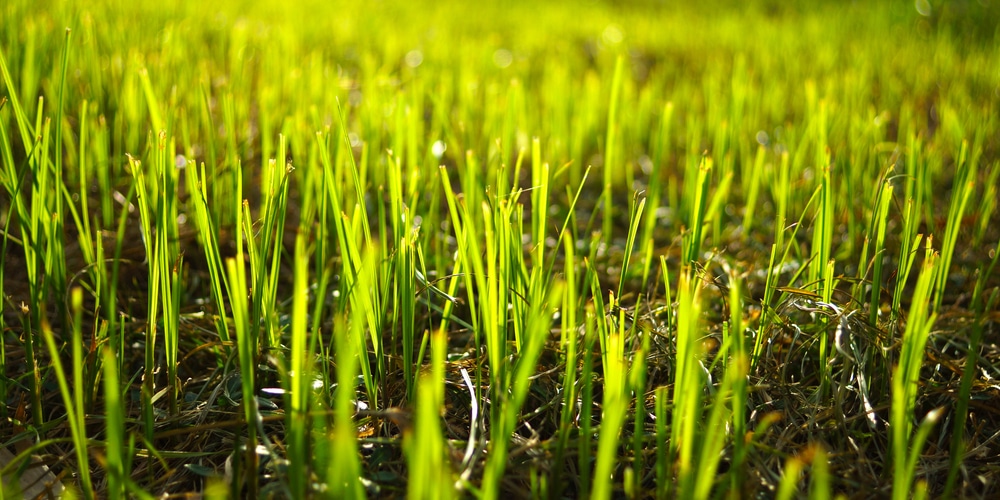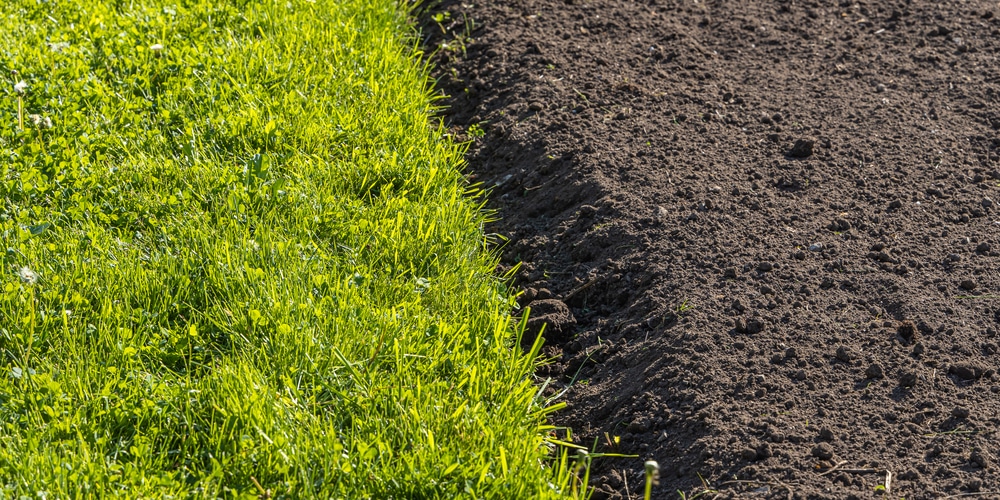Grass Seed Germination Basics
Grass seed germination is a critical stage in establishing a lush, green lawn. This section demystifies the germination process and provides you with practical insights to ensure your seeding efforts are successful.
Optimal Conditions for Germination
To maximize your grass seed’s potential, you need to provide:
- Moisture: Consistent dampness, not soaking wet or dry, is crucial for germination.
- Temperature: Grass seeds germinate best when soil temperatures are between 50°F and 65°F.
- Soil Contact: Seeds need good contact with soil, which means lightly raking them in or using a roller after seeding.
- Light: Some seeds require light to germinate, so avoid burying them too deeply.
Common Misconceptions About Watering
You might be tempted to flood your seeds to ensure they grow, but here’s what you should know:
- Frequency Over Quantity: It’s better to water lightly and frequently rather than drenching your lawn.
- Seeds can drown or rot with too much water at once, learn the balance from debunking grass seed watering myths.
The Truth About Germination Times
Germination time can vary, and here’s why:
- Seed Type: Different grass seeds, like ryegrass or fescue, have varying germination periods.
- Environmental Conditions: Cooler temperatures can extend germination time beyond the typical 5-30 days.
- Each grass type has its timeline; patience is key, as outlined in the guide to grass seed germination times.
Choosing the Right Grass Seed

Selecting the proper grass seed is crucial for a lush and healthy lawn. The right decision depends on assessing seed quality, deciphering seed labels accurately, and disentangling common myths regarding grass types and their appropriate blends.
Evaluating Seed Quality
- Pure Live Seed (PLS) Percentage: It’s vital to ensure that you’re purchasing seed with a high PLS percentage, which indicates the proportion of viable seeds in the bag that are capable of germination.
- Date of Test: Always check for a recent test date on the seed package to confirm freshness, as older seeds may have reduced germination rates.
Seed Labels Explained
- Species and Variety: The label should list the species and varieties of grass present, allowing you to choose a seed that matches your region’s climate and your yard’s specific conditions.
- Germination Rate: This percentage shows the likelihood of the seeds sprouting. Aim for a high germination rate to increase your lawn’s success rate.
- Noxious Weeds: Quality seed mixtures contain minimal or no noxious weed seeds. Pay attention to this detail to save yourself the hassle of dealing with weeds later.
Myths About Grass Types and Blends
- Shade Tolerance: Some believe that certain grass types are entirely shade-tolerant, but the truth is, all grasses require a degree of sunlight. Seek seeds labeled for shade if your yard doesn’t receive full sun. *
- One Type Fits All: Grass seed isn’t one-size-fits-all. Cool-season grasses thrive in northern climates, while warm-season grasses do better in the south. Tailor your choice to your environment for optimal growth. *
Soil Preparation Myths
When preparing soil for grass seeding, misconceptions about soil types and fertilizers can mislead even the most diligent gardeners. It’s crucial that you separate fact from fiction to ensure the healthiest start for your new lawn.
The Myth of the Perfect Soil Type
Common belief: There is a single soil type that is best for growing grass.
- Reality: Grass can thrive in various soil types with proper amendments.
- Key Points:
- Loam is often recommended due to its balanced structure, but other soil types can be suitable if conditioned correctly.
- Adjustments: Your native soil can be improved with compost, aeration, and proper pH adjustments to suit grass seed needs.
Fertilizer Misconceptions
Common belief: Applying fertilizer is necessary for any new grass seed to grow successfully.
- Reality: The need for fertilizer depends on soil condition and the specific needs of the grass type you’re planting.
- Key Points:
- Overuse: Excessive use can harm seedlings and lead to nutrient runoff.
- Timing: The best time to fertilize is when soil tests indicate a deficiency that needs addressing to match grass species requirements.
Maintenance and Care Post-Planting
After planting your grass seeds, proper maintenance ensures that your lawn grows healthy and vibrant. Your actions during the early stages of growth are crucial for establishing a resilient turf.
Mowing Myths
- Myth: Mow your lawn as short as possible – Cutting your grass too short can stress the grass, making it more susceptible to diseases and weed invasion. Aim to keep your grass at the ideal height, which typically ranges from 2.5 to 3 inches. This height helps to promote root growth and maintain moisture.
- Myth: It’s best to mow in the same pattern every time – Alternating your mowing pattern prevents ruts in the lawn and ensures grass blades grow straight and healthy. Regularly change your mowing direction to encourage a thicker, more resilient lawn.
The Reality of Overseeding
- Timing is key – The best overseeding results are achieved when timed with your grass type’s natural period of active growth. For cool-season grasses, early fall is optimum, while warm-season grasses benefit most from late spring seeding.
- Seed-to-soil contact – Overseeding success hinges on good seed-to-soil contact. Remove any debris and loosen the top layer of soil before spreading seed. This helps the seeds germinate effectively and establish a dense, lush lawn.
Seasonal and Environmental Considerations
When it comes to planting grass seed, knowing the right time and understanding your local environment are key to a vibrant lawn.
Debunking Seasonal Planting Myths
- Myth 1: “Spring is the only time to plant grass seed.” In fact, for cool-season grasses, autumn can be the most optimal time. This gives the grass a chance to establish itself with less competition from weeds, which are less active during the fall.
- Examples include: Kentucky bluegrass and fescue.
- Myth 2: “Grass seed can’t be planted in the winter.” While it’s true that seeds won’t germinate in frozen soil, the practice known as dormant seeding involves planting just before the onset of winter. The seeds will remain dormant until temperatures rise in early spring. This technique can be particularly effective as seeds are already in place to take advantage of the first warm weather. Read more about seasonal tips for planting grass seed.
Addressing Climate Misconceptions
- Myth 3: “All grass seeds are the same regardless of climate.”
Grass seed types vary widely, and each has its own preferred growing conditions.
What thrives in an arid climate may struggle in a humid one and vice versa.
- For warm climates, Zoysia and Bermudagrass are often recommended.
- For cooler climates, you might opt for Ryegrass or Bluegrass.
- Myth 4: “Artificial grass is environmentally detrimental.”
While there are environmental considerations for any landscaping choice, artificial grass has some advantages.
These include the reduction of water usage and no need for fertilizers or pesticides.
The environmental advantages of artificial grass can be found on the Shawgrass website.
Frequently Asked Questions
In this section, we tackle prevalent myths about grass seed, covering how to effectively establish new lawns, germination success on different soils, and optimal overseeding techniques.
What are the common misconceptions about using grass seed?
-
- Grass seed application is often misunderstood.
One common myth is that applying lime is part of routine lawn maintenance, when in reality, lime adjusts soil pH, not fertility.
How effective is grass seed in establishing a new lawn?
-
- Grass seed is very effective for new lawns, but results can vary widely based on seed quality, preparation, and care.
The new lawn coverage rate indicated on seed packages provides guidance on seeding density for optimal growth.
What is the success rate of grass seed germination on various soil types?
- Germination success rates depend on soil quality, moisture, temperature, and seed type:
- Well-aerated, loamy soils typically yield the best germination rates.
- Clay and sandy soils may require soil amendments for improved germination.
What are the best practices for overseeding an existing lawn?
- For overseeding existing lawns, key practices include:
- Mowing your lawn short before seeding.
- Ensuring good seed-to-soil contact.
- Watering consistently to maintain moist soil until germination.
Does each grass seed produce only one blade of grass?
- No, a single grass seed can give rise to a grass plant that develops multiple blades, called tillers, from its base.
What are the environmental factors that affect grass seed growth?
- Several environmental factors influence grass seed growth:
- Sunlight exposure is critical for photosynthesis and growth.
- Temperature plays a significant role in germination and growth rate.
- Water availability affects seed germination and overall health of the grass.
Last update on 2025-04-04 / Affiliate links / Images from Amazon Product Advertising API



